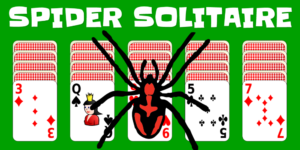Spider solitaire is a fairly easy yet addictive game to play if you get the rules. Understandably enough, people say the rules are a bit complicated, especially for those who have never been associated with the solitaire games. This is why we present to you the rules of playing Spider Solitaire.
Difficulty:
The difficulty of the game can be varied from very easy to very difficult. This depends on how many suits you decide to keep in your game. Naturally, the games with a single suit are the easiest ones and are pretty much guaranteed wins, the games with two suits are slightly more difficult and the wins are not that guaranteed whereas the games with four suits are very difficult and you have to be a bit of an expert with great luck to trump this level.
Objective of the Game:
The objective of the game is to build card sequences in descending order (K to A) of matching suits so that one sequence can be removed from the board. When all the cards are removed from the board, you win the game.
Layout of the Cards:
There are three places on the board where the cards are placed: the tableau, the foundation and the stock. The tableau is at the top with ten rows of five cards each laid out with the topmost card laying face up on the pile. The foundation is where all the completed suits are placed and the stock is a new deal of 10 cards placed on the tableau in the order in which they are placed.
Rules:
You can move the top most card of each pile in the tableau and place it on a card of one higher degree anywhere on the tableau. This card could be of the same suit which the card you have picked is of, or even a different suit.
One thing you must keep in mind is that you can only move a whole pile of cards when it is in of correct, descending order with all the cards in matching suit. Any pile that has even a single card of a different suit or cards that are out of the required order will be rendered unmovable till fixed.
When you have no more moves left to play on the board, you can deal ten cards from the stock to the piles of cards on the tableau in the exact order that they are placed, from left to right. This will mess up the order of the cards on the board and leave most pile immovable but you will have new moves to play.
Things to remember:
- You can only place a card on another card that is one degree higher (Q on K, 2 on 3, etc.)
- You must not leave any empty cells when dealing from the stock
- Any card can be placed on an empty cell
- You can deal from the stock anytime you wish








